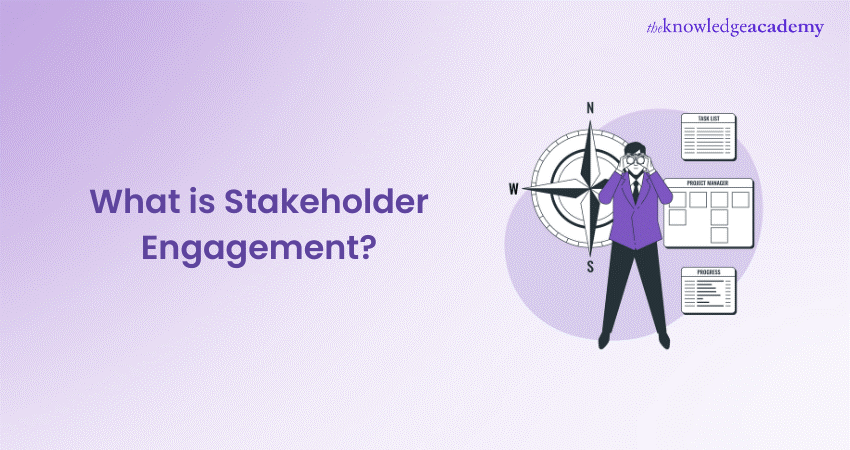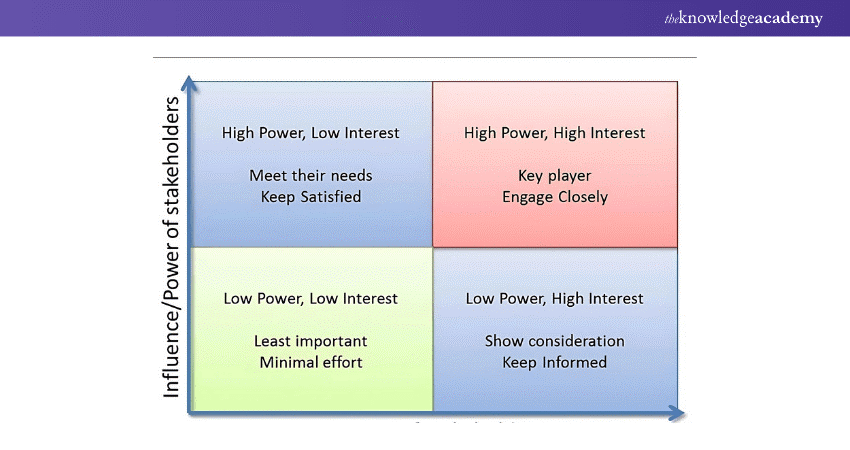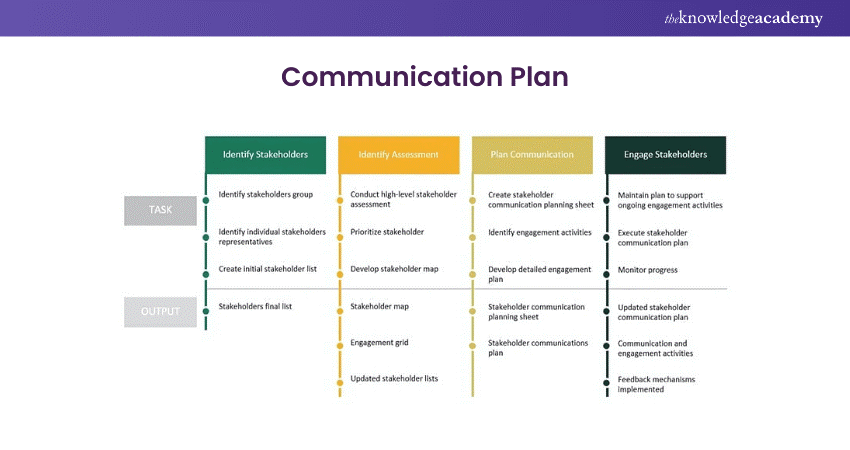We may not have the course you’re looking for. If you enquire or give us a call on 01344 203999 and speak to our training experts, we may still be able to help with your training requirements.
Training Outcomes Within Your Budget!
We ensure quality, budget-alignment, and timely delivery by our expert instructors.

In the current ever-changing business landscape, the success of projects relies on the connections you create and maintain with your stakeholders. Engaging stakeholders, whether they be customers, employees, or investors, is crucial to ensuring that your projects meet their needs and interests.
What does Stakeholder Engagement involve, precisely? How can you perfect the skill of juggling their varied expectations while reaching your project objectives?
Engaging stakeholders includes actively communicating, consulting early, and being transparent with everyone involved in a project. When performed accurately, it promotes ownership, reduces risks, and paves the way for success. In this detailed blog, we will examine the fundamentals of involving Stakeholders and developing successful Engagement strategies.
Table of Contents
1) What is Stakeholder Engagement?
2) Stakeholder Engagement Principles
3) What is a Stakeholder Engagement Plan?
4) How to use Stakeholder Engagement Plan?
5) Stakeholder Engagement Plan Benefits
6) Stakeholder Engagement Examples
7) Conclusion
What is Stakeholder Engagement?
Engaging stakeholders involves communicating and working with individuals who hold sway, interest, or are affected by an organisation, its projects, products, or services. This procedure includes recognising, examining, and ranking stakeholders to prepare and execute measures for successful involvement.
Stakeholders frequently participate in projects for financial or strategic reasons. The level of interest and influence in your project will vary based on their motivations. It is essential to understand how to adjust your communication approach according to the needs of stakeholders in order to give preference to those who have the most significant influence.
Stakeholder Engagement Principles
Engaging with Stakeholders and managing their involvement are seen as crucial elements for successful project completion despite being sometimes viewed as secondary tasks or ones that can be delegated to routine business functions. Project managers rely on individuals to react to the results and advantages they provide. Individuals will only react if they are actively involved.
1) Effective Communication
a) Understand the Stakeholders you'll be collaborating with throughout the project’s life cycle before attempting to involve or influence them.
b) Sharing information with Stakeholders is important, but equally crucial is gathering information about your Stakeholders in advance.
2) Early Consultation
a) In the early stages, projects may be unclear to Stakeholders regarding purpose, scope, risks, and approach.
b) Early and regular consultation is essential to clarifying and agreeing on project requirements.
c) Engaging Stakeholders early helps negotiate a delivery solution that is acceptable to the majority.
3) Human Element
a) Acknowledge that Stakeholders may act irrationally, unreasonably, inconsistently, and unpredictably.
b) Navigate interactions by considering emotions and potential ulterior motives.
c) Identify the reasons behind Stakeholder behaviour to find more effective collaboration methods.
d) Focus on maintaining a productive and successful partnership despite challenges.
4) Strategic Planning
a) Long-term Perspective: Incorporate Stakeholder engagement into the broader long-term plan, rather than treating it as a single, isolated event.
b) Methodical Strategy: Create a precise outline for interacting with stakeholders throughout various phases of the project.
c) Goal Congruence: Ensure that Stakeholder involvement efforts are in sync with the project's overall goals and results.
d) Customised Approaches: Personalise involvement tactics according to Stakeholder's requirements, preferences, and impact.
5) Relationship Focus
a) Building connections enhances confidence among team members and Stakeholders.
b) Trust leads to smoother, more efficient collaboration.
c) Identifying and cultivating relationships with Stakeholders boosts overall project confidence.
d) Strong connections reduce ambiguity in the project.
e) Effective relationships accelerate problem-solving and decision-making processes.
6) Simplicity Matters
a) Utilise foresight to predict potential risks during project planning.
b) Implement straightforward and timely measures with Stakeholders to address risks.
c) This approach significantly enhances project completion.
d) Despite its effectiveness, this principle is often not implemented well in practice.
7) Risk Management
a) Involving stakeholders helps identify potential risks early.
b) Considering their concerns and incorporating their viewpoints strengthens risk management.
c) A robust risk management plan ensures better project protection and success.
8) Reach Compromise
a) Determine the most suitable starting point for addressing stakeholders' differing expectations and priorities.
b) Evaluate the significance of each Stakeholder in relation to the project.
c) Create a prioritised hierarchy of Stakeholders based on project needs.
d) Ensure the hierarchy is approved by the project Sponsor.
9) Success Definition
a) Project success is subjective and can vary for different Stakeholders.
b) Understand each Stakeholder's perspective on what success looks like.
c) Define success in the specific context of project completion to align expectations.
10) Accountability Counts
a) Stakeholder Engagement is a shared responsibility among all project team members.
b) Every team member in the group should understand their specific role and follow the correct communication and engagement methods.
c) Successful project governance requires clearly defining Stakeholder roles and responsibilities.
d) Setting clear expectations for all participants is crucial for smooth project execution.
Transform business processes into clear with our Business Process Mapping Training Join today!
What is a Stakeholder Engagement Plan?
A Stakeholder Engagement Plan (SEP) outlines the level of involvement and influence that Stakeholders have on the project. It also details the communication strategy, specifying when and how each Stakeholder will be contacted, the platform to be used, and the amount of information to be shared.
Stakeholders can include team members or external parties affected by the project's progress and outcomes. This ensures that everyone remains informed and engaged throughout the project's lifecycle.
a) Internal Stakeholders might consist of project managers, operations teams, department heads, and board members.
b) External Stakeholders could consist of clients, customers, investors, suppliers, business partners, or shareholders.
How to use Stakeholder Engagement Plan?
The following are the steps of the Stakeholder Engagement Plan which need to be followed:
Identify Relevant Stakeholders
To begin crafting a Stakeholder Engagement Plan, the initial task is to identify all individuals or groups with a keen interest in the project. This encompasses both internal and external stakeholders, including employees, customers, investors, suppliers, and regulatory bodies.
Categorise Stakeholders by Interest/Influence
After determining Stakeholder influence and interest levels, you will place each Stakeholder on the influence/interest grid. This information may not be suitable for sharing with Stakeholders, but it can assist in establishing the appropriate communication style and frequency for each person.

Design a Communication Plan
A communication plan is important as it highlights how you will educate and update your Stakeholders. Despite their level of contribution, make sure that Stakeholders have access to suitable project information. The most efficient way to target this is by gathering all project details in a single location, such as a project management tool (PMT).
This allows Stakeholders to obtain real-time insights into the project’s status or gain an overview of the entire project timeline.

Revise with Feedback
It is important to keep in mind that Stakeholders may alter their behaviour during a project, so the positions on the interest/influence grid are not permanent. You have the ability to update your plan according to changes in behaviour and also to seek input from Stakeholders by sharing your plan with them. Being transparent about your expectations is key to receiving valuable feedback from Stakeholders.
Unlock your organisation’s potential with our precise Statistical Process Control Training Sign up now!
Stakeholder Engagement Plan Benefits
A well-developed plan for engaging Stakeholders assists your team in informing and educating them. Additional advantages of SEPS include:
a) Manages Expectations: Ensures Stakeholders are informed about the project's direction and each phase's anticipated outcomes.
b) Minimises Project Risks: by preventing Stakeholders from implementing major changes that could jeopardise the project's success.
c) Fosters Trust: Enhances connections among team members and Stakeholders.
d) Enhances Decision Making: by facilitating anticipation of Stakeholders' needs and desires in order to decide on the next course of action.
e) Encourages Teamwork: Effective communication enables teams to collaborate and generate ideas more efficiently.
Stakeholder Engagement Examples
The examples of Stockholder Engagement are:
a) Urban Development Project: In a city redevelopment initiative, early engagement with residents, business owners, and local government helps ensure the project meets community needs, reducing opposition and facilitating smoother execution.
b) Product Launch: When the company is launching a new product, it might involve Stakeholders such as customers, suppliers, and marketing teams early in the process to gather feedback and refine the product offering.
c) Non-Profit Organisation: A non-profit might engage donors, volunteers, and beneficiaries to ensure its programs align with community needs, thereby enhancing the impact of its initiatives.
Conclusion
Effective Stakeholder Engagement is vital for project success. By fostering open communication, building relationships, and involving Stakeholders in decision-making, you can mitigate risks, build trust, and align expectations. A robust engagement strategy enhances project integrity, whether for small initiatives or large organisations, ensuring long-term success.
Gain Competitive Edge with our Expert-led Business Analyst Course Register now!
Frequently Asked Questions

The main objective of involving stakeholders is to establish solid, cooperative connections through encouraging transparent communication, dealing with issues, and harmonising Stakeholder interests with project goals, ultimately guaranteeing project success and continued support.

Important factors to consider when involving Stakeholders are recognising appropriate Stakeholders, comprehending their concerns, promoting transparent communication, engaging them from the beginning, addressing issues, establishing trust, staying adaptable, and maintaining responsibility throughout the project.

The Knowledge Academy takes global learning to new heights, offering over 30,000 online courses across 490+ locations in 220 countries. This expansive reach ensures accessibility and convenience for learners worldwide.
Alongside our diverse Online Course Catalogue, encompassing 19 major categories, we go the extra mile by providing a plethora of free educational Online Resources like News updates, Blogs, videos, webinars, and interview questions. Tailoring learning experiences further, professionals can maximise value with customisable Course Bundles of TKA.

The Knowledge Academy’s Knowledge Pass, a prepaid voucher, adds another layer of flexibility, allowing course bookings over a 12-month period. Join us on a journey where education knows no bounds.

The Knowledge Academy offers various Business Analyst Courses, including the Effective Stakeholder Management Training, and the Process Mapping Training. These courses cater to different skill levels, providing comprehensive insights into Mind Map.
Our Business Analysis Blogs cover a range of topics related to Stakeholder Management, offering valuable resources, best practices, and industry insights. Whether you are a beginner or looking to advance your Analysis skills, The Knowledge Academy's diverse courses and informative blogs have got you covered.
Upcoming Business Analysis Resources Batches & Dates
Date
 Creating Effective Stakeholder Engagement Training
Creating Effective Stakeholder Engagement Training
Fri 7th Feb 2025
Fri 2nd May 2025
Fri 5th Sep 2025
Fri 5th Dec 2025







 Top Rated Course
Top Rated Course



 If you wish to make any changes to your course, please
If you wish to make any changes to your course, please


